|
| Name Origin | From the Latin cerussa, the name of an artificial lead carbonate |
|---|---|
| Chemical Formula | PbCO3 |
| Color | Colorless, white, gray, smoky, greenish (Cu inclusions), yellowish |
| Hardness | 3-3.5 on the Mohs scale |
| Crystal System | Orthorhombic. Crystals common, elongated, tabular, often twinned and striated; acicular, massive |
| Cleavage | Distinct 1 direction |
| Fracture | Conchoidal, extremely brittle |
| Specific Gravity (SG) | 6.55 |
| Lustre | Adamantine to submetallic; vitreous; resinous; pearly |
| Pleochroism | None |
Note: Cut cerussite is as beautiful as diamond since it has higher dispersion, is usually free of any body color, and has an adamantine luster. However, cerussite is extremely soft and one of the most brittle and heat sensitive of all minerals. Cutting a gem is a major chore, and cutting a very large one without breaking it is almost impossible. Consequently, faceted cerussite is one of the rarest of all gems.
Continue reading about more color stones
Brucite
Barite
Morganite
Grandidierite
Euxenite
Inderite
Kornerupine
Kurnakovite
Aragonite
Spodumene
Leucite
Danburite
Zincite
Chert
cerussite
Cordierite
Coral
Crocoite
Brucite
Barite
Morganite
Grandidierite
Euxenite
Inderite
Kornerupine
Kurnakovite
Aragonite
Spodumene
Leucite
Danburite
Zincite
Chert
cerussite
Cordierite
Coral
Crocoite
Photo Credit: www.shutterstone.com


